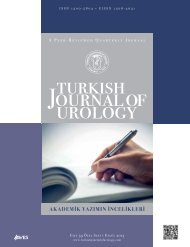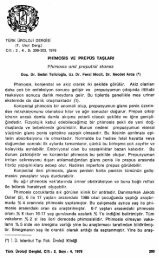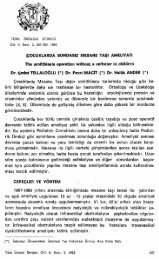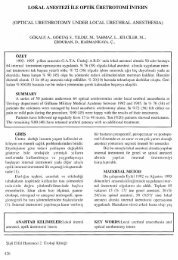Salvage therapies for radiorecurrent prostate cancer
Salvage therapies for radiorecurrent prostate cancer
Salvage therapies for radiorecurrent prostate cancer
Create successful ePaper yourself
Turn your PDF publications into a flip-book with our unique Google optimized e-Paper software.
350<br />
Turkish Journal of Urology 2011; 37(4): 350-356 • doi:10.5152/tud.2011.067<br />
UROONCOLOGY<br />
Review<br />
<strong>Salvage</strong> <strong>therapies</strong> <strong>for</strong> <strong>radiorecurrent</strong> <strong>prostate</strong> <strong>cancer</strong><br />
Radiorekürren prostat kanseri için salvage terapiler<br />
Mahmoud Othman Mustafa, Louis L. Pisters<br />
University of Texas, MD<br />
Anderson Cancer Center,<br />
Department of Urology,<br />
Surgery Division, Houston,<br />
Texas, USA<br />
Submitted:<br />
09.08.2011<br />
Accepted:<br />
01.11.2011<br />
Correspondence:<br />
Mahmoud Othman Mustafa<br />
University of Texas, MD<br />
Anderson Cancer Center, The<br />
Department of Urology, Surgery<br />
Division, Houston, Texas, USA<br />
Phone: +1 832 488 7257<br />
E-mail: dr_mahmoud68@yahoo.com<br />
©Copyright 2011 by Turkish<br />
Association of Urology<br />
Available online at<br />
www.turkishjournalofurology.com<br />
ABSTRACT<br />
Locally recurrent <strong>prostate</strong> <strong>cancer</strong> after radiation therapy, also known as <strong>radiorecurrent</strong> <strong>prostate</strong> <strong>cancer</strong>,<br />
has an unfavorable prognosis. Two-thirds of patients with <strong>radiorecurrent</strong> <strong>prostate</strong> <strong>cancer</strong> have an advanced<br />
pathological disease status by the time they undergo salvage therapy. Several salvage <strong>therapies</strong> <strong>for</strong> <strong>radiorecurrent</strong><br />
<strong>prostate</strong> <strong>cancer</strong> are available. <strong>Salvage</strong> radical <strong>prostate</strong>ctomy (SRP) and salvage cryoablation are<br />
the most feasible and effective <strong>therapies</strong> <strong>for</strong> <strong>radiorecurrent</strong> <strong>prostate</strong> <strong>cancer</strong>. Although SRP is technically<br />
more difficult and has a higher complication rate than do other salvage <strong>therapies</strong>, the procedure provides<br />
a long-term survival benefit. Preliminary studies of salvage robot-assisted radical <strong>prostate</strong>ctomy (SRARP)<br />
suggest that SRARP may be similar to or at least as effective as SRP. The intermediate oncological efficacy<br />
and morbidity of salvage cryoablation are similar to those of SRP. Prognostic factors <strong>for</strong> successful salvage<br />
therapy include serum <strong>prostate</strong>-specific antigen level ≤10 ng/mL, Gleason score ≤8, and a clinical disease<br />
stage T1c or T2. Assessing the comparative oncological efficacy and complications of the available salvage<br />
<strong>therapies</strong> <strong>for</strong> <strong>radiorecurrent</strong> <strong>prostate</strong> <strong>cancer</strong> requires strict guidelines, including universal patient selection<br />
criteria and an intergrade definition of biochemical failure.<br />
Key words: Prostate; <strong>prostate</strong> <strong>cancer</strong>; <strong>prostate</strong>ctomy.<br />
ÖZET<br />
Radiorekürren prostat kanseri olarak da bilinen, radyasyon terapisi sonrası lokal rekürren prostat kanseri<br />
kötü prognoza sahiptir. Radiorekürren prostat kanserli hastaların üçte ikisinin, salvage terapi aldıkları<br />
sırada ileri patolojik evrede hastalıkları vardır. Radiorekürren prostat kanseri için birkaç salvage tedavi<br />
vardır. <strong>Salvage</strong> radikal <strong>prostate</strong>ktomi (SRP) ve salvage kriyoablasyon, radiorekürren prostat kanseri için en<br />
uygulanabilir ve etkili tedavilerdir. SRP, öteki salvage terapilerden teknik olarak daha zor ve daha yüksek<br />
komplikasyon oranlarına sahip olsa da, uzun dönem sağkalım avantajı vardır. <strong>Salvage</strong> robot yardımlı radikal<br />
<strong>prostate</strong>ktominin (SRARP) ilk sonuçları SRARP’nin en az SRP kadar veya benzer şekilde etkin olacağını<br />
göstermektedir. <strong>Salvage</strong> kriyoablasyonun orta dönem onkolojik etkinliği ve morbiditesi SRP’ninkine<br />
benzerdir. Başarılı salvage tedeavi için prognostik faktörler: prostat spesifik antijen seviyesi ≤10 ng/mL,<br />
a Gleason sckoru ≤8 ve T1c veya T2 klinik hastalık evresidir. Radiorekürrent prostat kanserinin mevcut<br />
salvage tedavilerinin karşılaştırmalı onkolojik etkinlik ve komplikasyonlarını değerlendirmek için evrensel<br />
hasta seçim kriterlerini içeren ve evreler arası biyokimyasal başarısızlık tanımını içeren katı kılavuzlara<br />
ihtiyaç vardır.<br />
Anahtar sözcükler: Prostat; prostat kanseri; <strong>prostate</strong>ktomi.<br />
Uncontrolled local disease is a significant risk factor<br />
<strong>for</strong> metastatic progression, <strong>cancer</strong>-specific mortality,<br />
and considerable morbidity. Biochemical<br />
recurrence (BCR) of <strong>prostate</strong> <strong>cancer</strong> occurs in<br />
40-50% of patients who receive primary therapy<br />
with external beam radiation therapy or brachytherapy<br />
<strong>for</strong> localized disease. [1,2]. Seventy-two<br />
percent of patients who have an increasing<br />
serum <strong>prostate</strong>-specific antigen (PSA) level<br />
and a negative metastatic evaluation after<br />
radiation therapy have local <strong>prostate</strong> <strong>cancer</strong><br />
recurrence, as evidenced by positive rates<br />
of <strong>prostate</strong> biopsy. [3] Local salvage therapy,<br />
defined as further local treatment <strong>for</strong> clinically<br />
proven disease recurrence following initial<br />
local therapy, is the only approach that has<br />
curative potential in such patients. <strong>Salvage</strong><br />
therapy is given in the context of a detectable<br />
PSA after initial surgery or a rising PSA profile<br />
after initial radiation therapy. No consensus on<br />
when and how to detect and cure radio recurrent<br />
<strong>prostate</strong> <strong>cancer</strong> exists, but strong evidence<br />
indicates that salvage <strong>therapies</strong> may improve<br />
survival rates in patients with <strong>prostate</strong> <strong>cancer</strong>.
Mustafa et al.<br />
<strong>Salvage</strong> <strong>therapies</strong> <strong>for</strong> <strong>radiorecurrent</strong> <strong>prostate</strong> <strong>cancer</strong><br />
Table 1. Findings of studies on salvage radical <strong>prostate</strong>ctomy<br />
Studies Patients Follow-up BCR BDFS 10-year<br />
(n) (years) definition (%) CSS<br />
(PSA, ng/mL) (%)<br />
Pisters et al. [8] 42 7.8 ≥0.4 61% NR<br />
Ward et al. [5] 138 7 ≥0.4 58% 77%<br />
Bianco et al. [4] 100 5 ≥0.2 55% 73%<br />
Amling et al. [6] 108 Ns ≥0.2 44% 70%<br />
BCR: biochemical recurrence, BDFS: biochemical disease-free survival, CSS: <strong>cancer</strong>-specific<br />
survival, PSA: <strong>prostate</strong>-specific antigen, NR: not reported.<br />
Table 2. Complications of salvage radical <strong>prostate</strong>ctomy<br />
[n (%)]<br />
Studies (years)<br />
Amling Stephenson Heidenreich<br />
et al. [6] et al. [9] et al. [11]<br />
(1992-1996) (1993-2003) (2004-2008)<br />
Number of patients 60 60 55<br />
Incontinence 30 (50%) 61% a 25 (45%)<br />
Anastomotic stricture 16 (27%) 19 (32%) 6 (11%)<br />
Blood transfusion 10 (17%) 17 (29%) 2 (4%)<br />
Rectal injury 3 (5%) 1 (2%) 2 (4%)<br />
Urinary fistula 0 1 (2%) 1 (2%)<br />
a reported at 5-years and includes years 1984-2003.<br />
Table 3. <strong>Salvage</strong> robotic-assisted radical <strong>prostate</strong>ctomy series<br />
Four whole-gland salvage <strong>therapies</strong> are available <strong>for</strong> <strong>radiorecurrent</strong><br />
<strong>prostate</strong> <strong>cancer</strong>: salvage radical <strong>prostate</strong>ctomy (SRP),<br />
salvage cryoablation (SCA), salvage brachytherapy (SBT), and<br />
salvage high-intensity focused ultrasound (SHIFU). Although<br />
these <strong>therapies</strong> offer benefit to patients with <strong>radiorecurrent</strong><br />
<strong>prostate</strong> <strong>cancer</strong>, few oncologists are familiar with their applications<br />
and outcomes. Herein, we discuss the efficacy and safety<br />
of each approach.<br />
<strong>Salvage</strong> radical <strong>prostate</strong>ctomy<br />
SRP is the most effective treatments <strong>for</strong> locally recurrent<br />
<strong>prostate</strong> <strong>cancer</strong> after initial radiation therapy. Of the available<br />
salvage <strong>therapies</strong> <strong>for</strong> <strong>radiorecurrent</strong> <strong>prostate</strong> <strong>cancer</strong>, only SRP<br />
results in <strong>cancer</strong> control <strong>for</strong> 10 years or more in a substantial<br />
proportion of patients. [4-7] Among reported patients who have<br />
undergone SRP <strong>for</strong> <strong>radiorecurrent</strong> <strong>prostate</strong> <strong>cancer</strong>, the 5-year<br />
biochemical disease-free survival (BDFS) rates are 55-61%,<br />
and the 10-year BDFS rate is 44% (Table 1). [4,6-8] The 10-year<br />
<strong>cancer</strong>-specific survival rate after SRP is 70-77% (Table 1).<br />
SRP also provides intermediate <strong>cancer</strong> control in patients at<br />
high-risk <strong>for</strong> disease progression. An estimated 51% of patients<br />
with <strong>radiorecurrent</strong> <strong>prostate</strong> <strong>cancer</strong> who have Gleason scores<br />
of 8-10 and/or rapid PSA doubling times are free of BCR at<br />
5 years after SRP alone. Pisters et al. [8] per<strong>for</strong>med a stratified<br />
control comparison of BDFS after SRP and SCA in patients<br />
with a presalvage PSA level
352<br />
significantly higher than that of patients who underwent SCA<br />
(21%, p
Mustafa et al.<br />
<strong>Salvage</strong> <strong>therapies</strong> <strong>for</strong> <strong>radiorecurrent</strong> <strong>prostate</strong> <strong>cancer</strong><br />
SRP and the high surgical complication rate in this patient population.<br />
[10] A few centers have presented data on salvage laparoscopic<br />
and robotic radical <strong>prostate</strong>ctomy, and the outcomes<br />
were comparable to those <strong>for</strong> open SRP. To our knowledge, only<br />
four studies have reported experience with conventional salvage<br />
laparoscopic radical <strong>prostate</strong>ctomy. [12-15] The series included<br />
only 9, 9, 7, and 15 patients, respectively; nevertheless, patient<br />
functional and oncological outcomes were comparable to those<br />
in patients who underwent open SRP. Rectal injury occurred<br />
in only 1 patient, and no anastomosis strictures were observed.<br />
The four series reported BCR-free rates of 71%, 89%, 55%, and<br />
73% at median follow-up times of 27, 12, 11, and 8 months,<br />
respectively. [12-15]<br />
The promising outcomes reported <strong>for</strong> laparoscopic SRP encouraged<br />
surgeons to begin using salvage robot-assisted radical<br />
<strong>prostate</strong>ctomy (SRARP) (Table 3). [16-18] Kaouk et al. [16] recounted<br />
their experience with SRARP in 4 patients, the first of such<br />
reports. Kaouk et al. [16] were unable to detect PSA levels following<br />
SRP throughout the follow-up period in all but one patient.<br />
Eandi et al. [17] have published the largest series of patients who<br />
underwent SRARP <strong>for</strong> <strong>radiorecurrent</strong> <strong>prostate</strong> <strong>cancer</strong>. Of the 18<br />
patients included in that series, 12 (67%) did not develop BCR;<br />
of the 6 patients in whom BCR did develop, 2 had a preoperative<br />
PSA level >10 ng/mL, 2 had multifocal positive surgical<br />
margins, and 2 had unifocal margin involvement. Eandi et al. [17]<br />
also reported promising functional results, noting that 6 patients<br />
(33%) regained continence after SRP. Boris et al. [18] reported on<br />
11 patients whose median follow-up time was 21 months. BCR<br />
was detected in just 3 patients, at 1, 2, and 43 months, respectively.<br />
Of the contemporary SRARP series authors, Boris et<br />
al. [18] reported the highest continence rate (80%), likely because<br />
they defined incontinent patients as those who used more than<br />
1 pad daily. The preliminary report of the SRARP experience<br />
at MD Anderson Cancer Center is also encouraging. In the MD<br />
Anderson series, continent patients were defined as those who<br />
did not need pads, and the continence rate was 53%. Of the 5<br />
series, 3 reported no urethrovesical strictures, and 2 reported<br />
stricture rates of 9% and 18%, respectively. [17,18] These series<br />
indicate that SRARP is feasible and safe in patients with locally<br />
recurrent <strong>prostate</strong> <strong>cancer</strong> after failure of radiation therapy and/<br />
or cryotherapy and suggest that the oncological and functional<br />
outcomes are comparable to those of open surgery. However,<br />
larger studies with longer follow-up periods are necessary to<br />
confirm these results.<br />
<strong>Salvage</strong> cryoablation<br />
SCA of the <strong>prostate</strong> gland <strong>for</strong> <strong>radiorecurrent</strong> <strong>prostate</strong> <strong>cancer</strong><br />
is less invasive and may have less morbidity than does SRP.<br />
Because SCA is much less technically demanding than SRP,<br />
it is per<strong>for</strong>med four times as often as SRP, which is per<strong>for</strong>med<br />
at only a limited number of academic centers. However, both<br />
procedures are underutilized to treat patients with radio recur-<br />
rent <strong>prostate</strong> <strong>cancer</strong>. [19,20] Recent improvements in SCA include<br />
advances in argon- and helium-based cytotechnology and the<br />
development of small-caliber cryoablation probes, pinpoint<br />
thermocouples, effective urethral warming devices, and software<br />
packages that facilitate optimal placement of cryoablation<br />
probes and thermocouples. [21]<br />
Although no randomized SCA studies have been per<strong>for</strong>med, single-center<br />
studies and pooled retrospective series demonstrate<br />
its effectiveness. The largest SCA multicenter series examined<br />
outcomes recorded in the Cryo On-Line Data Registry, a secure<br />
online database that tracks outcomes after cryoablation in academic<br />
and community settings. [22] Among the 279 patients with<br />
<strong>radiorecurrent</strong> <strong>prostate</strong> <strong>cancer</strong> who underwent SCA, the 5-year<br />
actuarial BCDF rates according to the American Society of<br />
Therapeutic Radiation Oncology (ASTRO) criteria (three successive<br />
rises in PSA level) and Phoenix criteria (the nadir PSA<br />
level plus 2 ng/dL) were 58.9% and 54.5%, respectively. [22] The<br />
outcomes reported in selected SCA series are summarized in<br />
Table 4. Patient PSA level, Gleason score, and androgen status<br />
be<strong>for</strong>e SCA convey prognostic in<strong>for</strong>mation and have been associated<br />
with disease-free and disease-specific survival. A PSA<br />
doubling time of 10 ng/mL be<strong>for</strong>e SCA had a higher BCR rate than did patients<br />
who had a PSA level ≤10 ng/mL be<strong>for</strong>e SCA. [25,26] Patients<br />
who had received only radiation therapy be<strong>for</strong>e SCA had a significantly<br />
higher 5-year disease-specific survival rate than did<br />
patients who had received both radiation therapy and hormonal<br />
therapy be<strong>for</strong>e SCA (89% and 50%, respectively; p
354<br />
Urinary incontinence, defined as any urinary pad usage, occurs<br />
in 4-10% of patients who undergo SCA. [23,27-29] The use of an<br />
external sphincter temperature probe has decreased severe<br />
incontinence rates to
Mustafa et al.<br />
<strong>Salvage</strong> <strong>therapies</strong> <strong>for</strong> <strong>radiorecurrent</strong> <strong>prostate</strong> <strong>cancer</strong><br />
Int J Radiat Oncol Biol Phys 2003;57:915-28. [CrossRef]<br />
3. Zagars GK, Pollack A, von Eschenbach AC. Prostate <strong>cancer</strong> and<br />
radiation therapy--the message conveyed by serum <strong>prostate</strong>specific<br />
antigen. Int J Radiat Oncol Biol Phys 1995;33:23-35.<br />
[CrossRef]<br />
4. Bianco FJ Jr, Scardino PT, Stephenson AJ, Diblasio CJ, Fearn<br />
PA, Eastham JA. Long-term oncologic results of salvage<br />
radical <strong>prostate</strong>ctomy <strong>for</strong> locally recurrent <strong>prostate</strong> <strong>cancer</strong> after<br />
radiotherapy. Int J Radiat Oncol Biol Phy 2005;62:448-53.<br />
[CrossRef]<br />
5. Ward JF, Sebo TJ, Blute ML, Zincke H. <strong>Salvage</strong> surgery <strong>for</strong><br />
<strong>radiorecurrent</strong> <strong>prostate</strong> <strong>cancer</strong>: contemporary outcomes. J Urol<br />
2005;173:1156-60. [CrossRef]<br />
6. Amling CL, Lerner SE, Martin SK, Slezak JM, Blute ML, Zincke<br />
H. Deoxyribonucleic acid ploidy and serum <strong>prostate</strong> specific<br />
antigen predict outcome following salvage <strong>prostate</strong>ctomy <strong>for</strong><br />
radiation refractory <strong>prostate</strong> <strong>cancer</strong>. J Urol 1999;161:857-63.<br />
[CrossRef]<br />
7. Cheng L, Sebo TJ, Slezak J, Pisansky TM, Bergstralh EJ,<br />
Neumann RM, et al. Predictors of survival <strong>for</strong> <strong>prostate</strong> carcinoma<br />
patients treated with salvage radical <strong>prostate</strong>ctomy after radiation<br />
therapy. Cancer 1998;83:2164-71. [CrossRef]<br />
8. Pisters LL, Leibovici D, Blute M, Zincke H, Sebo TJ, Slezak<br />
JM, et al. Locally recurrent <strong>prostate</strong> <strong>cancer</strong> after initial radiation<br />
therapy: a comparison of salvage radical <strong>prostate</strong>ctomy versus<br />
cryotherapy. J Urol 2009;182:517-25. [CrossRef]<br />
9. Stephenson AJ, Scardino PT, Bianco FJ Jr, DiBlasio CJ, Fearn PA,<br />
Eastham JA. Morbidity and functional outcomes of salvage radical<br />
<strong>prostate</strong>ctomy <strong>for</strong> locally recurrent <strong>prostate</strong> <strong>cancer</strong> after radiation<br />
therapy. J Urol 2004;172:2239-43. [CrossRef]<br />
10. Masterson TA, Stephenson AJ, Scardino PT, Eastham JA.<br />
Recovery of erectile function after salvage radical <strong>prostate</strong>ctomy<br />
<strong>for</strong> locally recurrent <strong>prostate</strong> <strong>cancer</strong> after radiotherapy. Urology<br />
2005;66:623-6. [CrossRef]<br />
11. Heidenreich A, Richter S, Thüer D, Pfister D. Prognostic<br />
parameters, complications, and oncologic and functional outcome<br />
of salvage radical <strong>prostate</strong>ctomy <strong>for</strong> locally recurrent <strong>prostate</strong><br />
<strong>cancer</strong> after 21st-century radiotherapy. Eur Urol 2010;57:437-43.<br />
[CrossRef]<br />
12. Nuñez-Mora C, García-Mediero JM, Cabrera-Castillo PM. Radical<br />
laparoscopic salvage <strong>prostate</strong>ctomy: medium-term functional and<br />
oncological results. J Endourol 2009;23:1301-5. [CrossRef]<br />
13. Stolzenburg JU, Bynens B, Do M, Rabenalt R, Katsakiori PF,<br />
Liatsikos E, et al. <strong>Salvage</strong> laparoscopic extraperitoneal radical<br />
<strong>prostate</strong>ctomy after failed high-intensity focused ultrasound and<br />
radiotherapy <strong>for</strong> localized <strong>prostate</strong> <strong>cancer</strong>. Urology 2007;70:956-60.<br />
[CrossRef]<br />
14. Vallancien G, Gupta R, Cathelineau X, Baumert H, Rozet FT.<br />
Initial results of salvage laparoscopic radical <strong>prostate</strong>ctomy after<br />
radiation failure. J Urol 2003;170:1838-40. [CrossRef]<br />
15. Ahallal Y, Shariat SF, Chade DC, Reuter VE, Sandhu JS, Laudone<br />
VP, et al. Pilot study of salvage laparoscopic <strong>prostate</strong>ctomy <strong>for</strong> the<br />
treatment of recurrent <strong>prostate</strong> <strong>cancer</strong>. BJU Int 2011;108:724-8.<br />
16. Kaouk JH, Hafron J, Goel R, Haber GP, Jones JS. Robotic salvage<br />
retropubic <strong>prostate</strong>ctomy after radiation/brachytherapy: initial<br />
results. BJU Int 2008;102:93-6. [CrossRef]<br />
17. Eandi JA, Link BA, Nelson RA, Josephson DY, Lau C, Kawachi<br />
MH, et al. Robotic assisted laparoscopic salvage <strong>prostate</strong>ctomy<br />
<strong>for</strong> radiation resistant <strong>prostate</strong> <strong>cancer</strong>. J Urol 2010;183:133-7.<br />
[CrossRef]<br />
18. Boris RS, Bhandari A, Krane LS, Eun D, Kaul S, Peabody JO.<br />
<strong>Salvage</strong> robotic assisted radical <strong>prostate</strong>ctomy: initial results and<br />
early report of outcomes. BJU Int 2009;103:952-6. [CrossRef]<br />
19. Pisters LL. Treatment failure after primary and salvage therapy <strong>for</strong><br />
<strong>prostate</strong> <strong>cancer</strong>. Cancer 2008;112:225-7. [CrossRef]<br />
20. Agarwal PK, Sadetsky N, Konety BR, Resnick MI, Carroll PR,<br />
Cancer of the Prostate Strategic Urological Research Endeavor<br />
(CaPSURE). Treatment failure after primary and salvage therapy<br />
<strong>for</strong> <strong>prostate</strong> <strong>cancer</strong>: likelihood, patterns of care, and outcomes.<br />
Cancer 2008;112:307-14. [CrossRef]<br />
21. Ward JF, Pagliaro LC, Pisters LL. <strong>Salvage</strong> therapy <strong>for</strong> <strong>radiorecurrent</strong><br />
<strong>prostate</strong> <strong>cancer</strong>. Curr Probl Cancer 2008;32:242-71. [CrossRef]<br />
22. Pisters LL, Rewcastle JC, Donnelly BJ, Lugnani FM, Katz AE,<br />
Jones JS. <strong>Salvage</strong> <strong>prostate</strong> cryoablation: initial results from the<br />
cryo on-line data registry. J Urol 2008;180:559-63. [CrossRef]<br />
23. Spiess PE, Lee AK, Leibovici D, Wang X, Do KA, Pisters LL.<br />
Presalvage <strong>prostate</strong>-specific antigen (PSA) and PSA doubling<br />
time as predictors of biochemical failure of salvage cryotherapy in<br />
patients with locally recurrent <strong>prostate</strong> <strong>cancer</strong> after radiotherapy.<br />
Cancer 2006;107:275-80. [CrossRef]<br />
24. Izawa JI, Madsen LT, Scott SM, Tran JP, McGuire EJ, Von<br />
Eschenbach AC, et al. <strong>Salvage</strong> cryotherapy <strong>for</strong> recurrent <strong>prostate</strong><br />
<strong>cancer</strong> after radiotherapy: variables affecting patient outcome.<br />
J Clin Oncol 2002;20:2664-71. [CrossRef]<br />
25. Pisters LL, Perrotte P, Scott SM, Greene GF, von Eschenbach AC.<br />
Patient selection <strong>for</strong> salvage cryotherapy <strong>for</strong> locally recurrent <strong>prostate</strong><br />
<strong>cancer</strong> after radiation therapy. J Clin Oncol 1999;17:2514-20.<br />
26. Spiess PE, Katz AE, Chin JL, Bahn D, Cohen JK, Shinohara K, et<br />
al. A pretreatment nomogram predicting biochemical failure after<br />
salvage cryotherapy <strong>for</strong> locally recurrent <strong>prostate</strong> <strong>cancer</strong>. BJU Int<br />
2010;106:194-8. [CrossRef]<br />
27. Bahn DK, Lee F, Silverman P, Bahn E, Badalament R, Kumar<br />
A, et al. <strong>Salvage</strong> cryosurgery <strong>for</strong> recurrent <strong>prostate</strong> <strong>cancer</strong> after<br />
radiation therapy: a seven-year follow-up. Clin Prostate Cancer<br />
2003;2:111-4.<br />
28. Han KR, Belldegrun AS. Third-generation cryosurgery <strong>for</strong> primary<br />
and recurrent <strong>prostate</strong> <strong>cancer</strong>. BJU Int 2004;93:14-8. [CrossRef]<br />
29. Donnelly BJ, Saliken JC, Ernst DS, Weber B, Robinson JW,<br />
Brasher PM, et al. Role of transrectal ultrasound guided salvage<br />
cryosurgery <strong>for</strong> recurrent <strong>prostate</strong> carcinoma after radiotherapy.<br />
Prostate Cancer Prostatic Dis 2005;8:235-42. [CrossRef]<br />
30. Cresswell J, Asterling S, Chaudhary M, Sheikh N, Greene D.<br />
Third-generation cryotherapy <strong>for</strong> <strong>prostate</strong> <strong>cancer</strong> in the UK: a<br />
prospective study of the early outcomes in primary and recurrent<br />
disease. BJU Int 2006;97:969-74. [CrossRef]<br />
31. Nguyen PL, D’Amico AV, Lee AK, Suh WW. Patient selection,<br />
<strong>cancer</strong> control, and complications after salvage local therapy <strong>for</strong><br />
postradiation <strong>prostate</strong>-specific antigen failure: a systematic review<br />
of the literature. Cancer 2007;110:1417-28. [CrossRef]<br />
32. Ahmed S, Lindsey B, Davies J. <strong>Salvage</strong> cryosurgery <strong>for</strong> locally<br />
recurrent <strong>prostate</strong> <strong>cancer</strong> following radiotherapy. Prostate Cancer<br />
Prostatic Dis 2005;8:31-5. [CrossRef]<br />
33. Eisenberg ML, Shinohara K. Partial salvage cryoablation of the<br />
<strong>prostate</strong> <strong>for</strong> recurrent <strong>prostate</strong> <strong>cancer</strong> after radiotherapy failure.<br />
Urology 2008;72:1315-8. [CrossRef]<br />
355
356<br />
34. Katz AE, Prepelica KL, Masson P, Benson MC, McKiernan JM.<br />
<strong>Salvage</strong> cryosurgical ablation of the <strong>prostate</strong> <strong>for</strong> patients failing<br />
radiation: 10 year experience. J Urol 2005;173:450.<br />
35. Chin JL, Pautler SE, Mouraviev V, Touma N, Moore K, Downey<br />
DB. Results of salvage cryoablation of the <strong>prostate</strong> after radiation:<br />
identifying predictors of treatment failure and complications.<br />
J Urol 2001;165:1937-41. [CrossRef]<br />
36. Ismail M, Ahmed S, Kastner C, Davies J. <strong>Salvage</strong> cryotherapy<br />
<strong>for</strong> recurrent <strong>prostate</strong> <strong>cancer</strong> after radiation failure: a prospective<br />
case series of the first 100 patients. BJU Int 2007;100:760-4.<br />
[CrossRef]<br />
37. Grado GL, Collins JM, Kriegshauser JS, Balch CS, Grado<br />
MM, Swanson GP, et al. <strong>Salvage</strong> brachytherapy <strong>for</strong> localized<br />
<strong>prostate</strong> <strong>cancer</strong> after radiotherapy failure. Urology 1999;53:2-10.<br />
[CrossRef]<br />
38. Koutrouvelis P, Hendricks F, Lailas N, Gil-Montero G, Sehn J,<br />
Khawand N, et al. <strong>Salvage</strong> reimplantation in patients with local<br />
recurrent <strong>prostate</strong> carcinoma after brachytherapy with three<br />
dimensional computed tomography guided permanent pararectal<br />
implant. Technol Cancer Res Treat 2003;2:339-44.<br />
39. Nguyen PL, Chen MH, D’Amico AV, Tempany CM, Steele<br />
GS, Albert M, et al. Magnetic resonance image-guided salvage<br />
barchytherapy after radiation in selected men who initially<br />
presented favorable-risk <strong>prostate</strong> <strong>cancer</strong>: a prospective phase 2<br />
study. Cancer 2007;110:1485-92. [CrossRef]<br />
40. Lee B, Shinohara K, Weinberg V, Gottschalk AR, Pouliot J,<br />
Roach M 3rd, et al. Feasibility of high-dose-rate brachytherapy<br />
salvage <strong>for</strong> local <strong>prostate</strong> <strong>cancer</strong> recurrence after radiotherapy: the<br />
Turkish Journal of Urology 2011; 37(4): 350-356<br />
doi:10.5152/tud.2011.067<br />
University of Cali<strong>for</strong>nia-San Francisco experience. Int J Radiat<br />
Oncol Biol Phys 2007;67:1106-12. [CrossRef]<br />
41. Trotti A, Colevas AD, Setser A, Rusch V, Jaques D, Budach V, et<br />
al. CTCAE v3.0: development of a comprehensive grading system<br />
<strong>for</strong> the adverse effects of <strong>cancer</strong> treatment. Semin Radiat Oncol<br />
2003;13:176-81. [CrossRef]<br />
42. Zacharakis E, Ahmed HU, Ishaq A, Scott R, Illing R, Freeman<br />
A, et al. The feasibility and safety of high-intensity focused<br />
ultrasound as salvage therapy <strong>for</strong> recurrent <strong>prostate</strong> <strong>cancer</strong><br />
following external beam radiotherapy. BJU Int 2008;102:786-92.<br />
[CrossRef]<br />
43. Murat FJ, Poissonnier L, Rabilloud M, Belot A, Bouvier R,<br />
Rouviere O, et al. Mid-term results demonstrate salvage highintensity<br />
focused ultrasound (HIFU) as an effective and acceptably<br />
morbid salvage treatment option <strong>for</strong> locally <strong>radiorecurrent</strong> <strong>prostate</strong><br />
<strong>cancer</strong>. Eur Urol 2008;55:640-9. [CrossRef]<br />
44. Gelet A, Chapelon JY, Poissonnier L, Bouvier R, Rouvière O,<br />
Curiel L, et al. Local recurrence of <strong>prostate</strong> <strong>cancer</strong> after external<br />
beam radiotherapy: early experience of salvage therapy using<br />
high intensity focused ultrasonography. Urology 2004;63:625-9.<br />
[CrossRef]<br />
45. Chalasani V, Martinez CH, Lim D, Chin J. <strong>Salvage</strong> HIFU <strong>for</strong><br />
recurrent <strong>prostate</strong> <strong>cancer</strong> after radiotherapy. Prostate Cancer<br />
Prostatic Dis 2009;12:24-9. [CrossRef]<br />
46. Rebillard X, Soulie M, Chartier-Kastler E, Davin JL, Mignard JP,<br />
Moreau JL, et al. High-intensity focused ultrasound in <strong>prostate</strong><br />
<strong>cancer</strong>; a systematic literature review of the French Association of<br />
Urology. BJU Int 2008;101:1205-13. [CrossRef]








